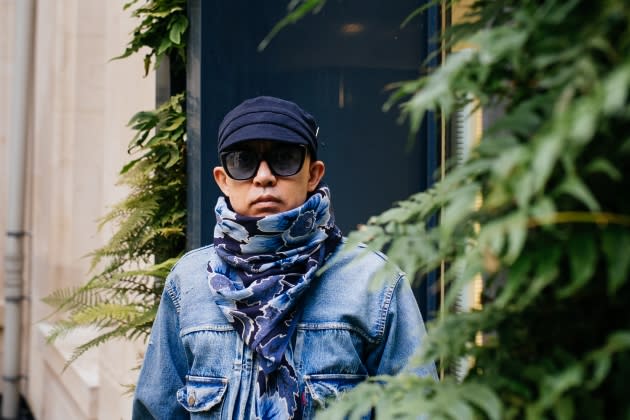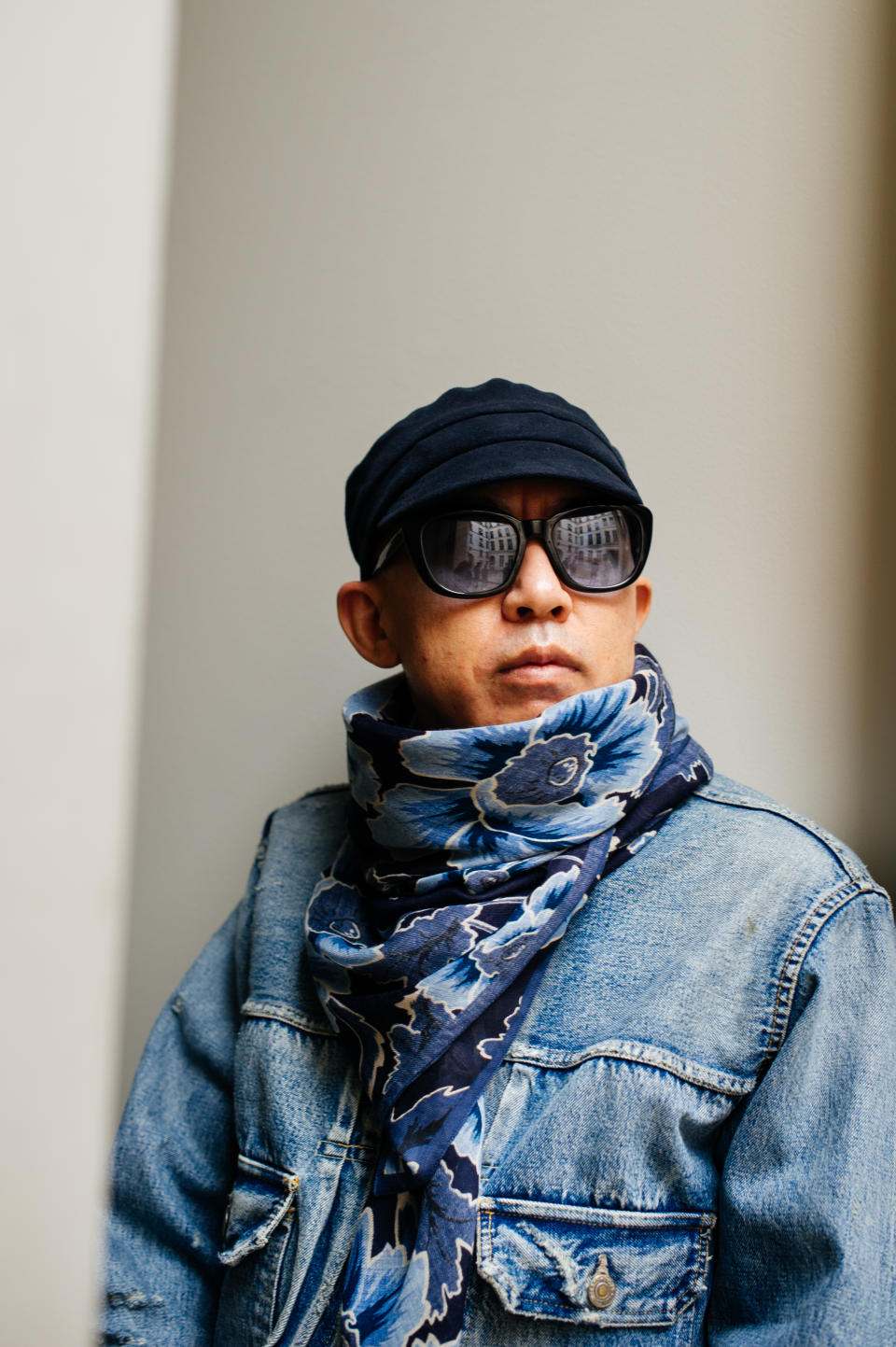Nigo Wants to Revive ‘Fun’ in Fashion at Kenzo
- Oops!Something went wrong.Please try again later.

Nigo was in junior high school in the 1980s when Japan experienced a boom in fashion designers, with Kenzo Takada among the most high-profile of the bunch.
“I was very aware of Kenzo and desired it, but didn’t have the money to buy it,” he recalled. “I followed it through fashion magazines and looked at the products in the stores.”
More from WWD
Once he accrued fame and success in fashion, as the founder of A Bathing Ape and other brands, Nigo scoured vintage resellers and bought a lot of the things he coveted from that formative period, amassing a collection of garments that he has yet to catalogue, but probably numbers in the hundreds.
“They’ve been very useful as I put together this first collection,” he said over Zoom from his Tokyo studio. “They provided some inspiration and backbone for what I want to do with Kenzo.”
In an exclusive interview with WWD, Nigo shared his passion for and knowledge of Kenzo Takada’s fashion legacy, his ambitions for the brand as its new creative director and his wish to reclaim the “fun and excitement” that Takada brought to fashion in the first place.
He is to unveil his first coed collection on Jan. 23 on the last day of men’s fashion week in Paris, taking over Galerie Vivienne, a covered passage dating back to 1823, its tiled floors bearing the grooves of almost two centuries of foot traffic. The venue is symbolic as Kenzo Takada staged his very first fashion show in April 1970 at his boutique in the Galerie Vivienne.
Expect winks back to the 1980s, when Nigo discovered Kenzo and fixed his image of the brand essence, along with some of the streetwear sensibility that is second nature to the designer, whose real name is Tomoaki Nagao.

Courtesy of Kenzo
When he was named to the creative helm of Paris-based Kenzo last September, it already appeared that Nigo was destined for the plum design post due to some surprising coincidences. He was born in 1970, the year Takada opened his first store in Paris; the two men graduated from the same fashion school in Tokyo, Bunka Fashion College, and Nigo started his fashion career the same year that the Kenzo maison became part of French luxury group LVMH Moët Hennessy Louis Vuitton.
In a wide-ranging conversation, Nigo shared other parallels, up to and including a similar creative method.
“Maybe it’s a Japanese thing, but the idea of taking in a lot of disparate influences from various cultures and in some way, managing to fuse them into something that feels like it has its own identity is something that I recognize in the way that Takada worked, and it’s something I’m very close to,” he explained, speaking in Japanese with an interpreter at his side. “The inputs may be different, but I think the process is similar.”
“He could write a book on Kenzo himself,” marveled Sidney Toledano, chairman and chief executive officer of LVMH Fashion Group, who selected Nigo to lead the storied house. “I was so impressed by the knowledge he had about Kenzo Takada. He has some archives that even we don’t have.”
Nigo acknowledged it was a challenge pulling together his debut fall 2022 collections given the time constraints, and the backdrop of the coronavirus pandemic, which has made travel between Japan and Continental Europe extremely complicated, meaning he had to largely acclimatize to a new team and ambitious project remotely.
Yet the designer seized the moment and took a positive approach.

Kuba Dabrowski/WWD
“There was no time to doubt the creative direction,” Nigo said. “It was absolutely clear what needed to be done, and I’m very proud of the way that the teams have come together and understood what I want to achieve, and I’m confident in the output.”
That said, the designer confessed that, despite having been in the fashion business for almost 30 years, he’s new to runway shows and judgment from fashion critics.
“I feel a little bit like a sumo wrestler asked to fight a UFC-style match,” he said with a laugh. “I can only hope that people like what I’ve done.”
The Tokyo-based designer launched A Bathing Ape (also known as Bape) in 1993. He sold the company to I.T. in 2011 for about $2.8 million and left the brand in 2013. Among his enduring Bape designs is his full-zip “shark” hoodie, which first came out in 2004 and recently enjoyed a resurgence in interest.
A serial fashion entrepreneur, Nigo also partnered with Pharrell Williams to launch the streetwear brands Billionaire Boys Club and Ice Cream, and introduced a brand called Human Made, which he wore for the interview: a camouflage-print jacket and a gray, logo T-shirt.
He said it’s obvious that his background in streetwear would influence his designs for Kenzo.
“The thing about streetwear is that it’s become the norm — it’s normal clothes, everyday wear, and extremely accepted now,” Nigo said. “But when I started my career 30 years ago, it was a kind of a counterculture and was not accepted as proper design. As a result, very few people were paying close attention to streetwear.”
In his view, as streetwear has practically become “the default manner of dressing, or even design in some ways,” there’s a gap in understanding of what is authentic to the category.
“From the perspective of the fashion world, streetwear has not been respected until very recently, whereas I’ve been focused on it for my entire career. So to me, it’s very clear when something’s wrong, when something’s an attempt.”
To be sure, he feels that the industry needs a jolt of fresh design.
“I feel that quite a lot in fashion at the moment is boring, and that fashion shows have kind of compensated in a way by hyping up the spectacle element as a distraction from the clothes,” he said. “I would like to reconnect with the sense of excitement that can come just from fashion itself.”
The designer confessed to a “parallel ambition for the creative process, for the people who are making the brand to have fun. I believe that if there’s a sense of excitement and fun in the internal creative process, that naturally flows into the stores and into the products.”
To be sure, that’s the legacy of the Takada himself, a fashion innovator who brought inventive cuts, multicultural inspirations, joyful color and exotic prints to the Paris fashion scene starting in the 1970s.
“The character of the house is fun and exciting. And that’s actually necessary in fashion today. Also, Kenzo is about the possibility for anyone to find fashion fun and exciting, so it brings people into the fashion world. It’s for everyone,” Nigo said.
He lauded Takada’s early fashion shows, which felt like happenings, and were among the first to make music an integral element of the spectacle.
When he was at Bunka College, Nigo didn’t study Takada directly as he was enrolled in fashion editorial courses, but he witnessed how many fashion students were influenced by him, even though the predominant mood in fashion at the time was dark and aloof, heavily influenced by Rei Kawakubo at Comme des Garçons, whose 1982 collection was titled “Destroy.”
While Nigo said he has great esteem for Kawakubo, he said he was drawn to the “colorful, fun, exciting character of Kenzo.”
“He was the the most high-profile and most famous alumnus of Bunka at the time. And he also used to have quite a deep interaction with the school. He used to come back and give lectures and interact with the students,” he said.
To be sure, Takada was a “true pioneer” in establishing himself in Paris as ready-to-wear was exploding, and also having a broad influence on the fashion scene, eliciting praise from the likes of Yves Saint Laurent and attracting fellow designers such as Karl Lagerfeld, Sonia Rykiel and Issey Miyake to his shows.
“It’s interesting because it’s somebody coming from the periphery, moving to the center and having an influence rather than the center spreading its influence outward,” Nigo said. “So that gave me a feeling of possibility, that I could do something outside of Japan as a fashion designer.…I’ve gained confidence from Kenzo sans example.”
Alongside his Human Made brand and role as Kenzo’s creative director, Nigo consults on corporate branding for Japanese digital company CyberAgent Inc., and owns a small chain of curry restaurants called Curry Up. He also has a sake brand with Williams, a frequent collaborator, under the Storm Cowboy brand.
A noted DJ and music producer, Nigo has a recording studio in his Tokyo design offices and does production for Japanese pop groups. In March, he plans to release a “collaboration album” on Universal Records that features the likes of Williams, Kid Cudi, A$AP Rocky and Tyler the Creator, all friends of the designer’s.
Nigo is the latest talent to helm Kenzo since Takada left his namesake fashion brand in 1999. Takada continued to support the brand under several creative configurations, and remained a popular and bubbly figure on the Paris fashion and social scene. He died in October 2020 at age 81 due to complications related to COVID-19.
LVMH initially appointed Gilles Rosier and Roy Krejberg to design the women’s and men’s lines, respectively. Italian designer Antonio Marras ultimately succeeded Rosier in 2004 and continued until 2011, when LVMH repositioned the brand in the then-burgeoning contemporary zone and conscripted Opening Ceremony founders Humberto Leon and Carol Lim to lead Kenzo. The duo won a following for tiger-logoed sweatshirts, slip-on sneakers and caps during their eight-year tenure.
Last April, Portuguese designer Felipe Oliveira Baptista wound up his two-year design tenure, during which he brought a sophisticated and artistic touch to Kenzo, partial to enveloping, nomadic silhouettes.
“It’s not an old brand that needs a reboot. It’s a brand that has maintained momentum. Kenzo was still on the radar thanks to its previous designers,” Toledano said, while acknowledging a desire to further ignite the brand’s development under Nigo.
“He has a very clear vision, in addition to his charisma and his personality,” Toledano said, also lauding him as a pioneer in melding his fashion projects with music, akin to the late Virgil Abloh, who was also a noted DJ and collaborated with Nigo on two LV2 capsule collections for Louis Vuitton in 2020 and 2021.
“The fact that Nigo has this music background, he understands this movement, he understands the new community worldwide,” Toledano said. “The new generation is so influenced by music.”
Toledano said it’s too early to talk about business ambitions, but cited an “excellent reaction” within the Kenzo house when Nigo’s appointment was revealed last September.
“The trade also is reacting very well,” he said. “We have a man with a passion for the brand and a vision. Nigo is here to write a story with several chapters.”
SEE ALSO:
Kenzo Picks Streetwear Guru Nigo as Its Next Designer
7 Facts to Know About Fashion Designer Kenzo Takada
Sign up for WWD's Newsletter. For the latest news, follow us on Twitter, Facebook, and Instagram.

